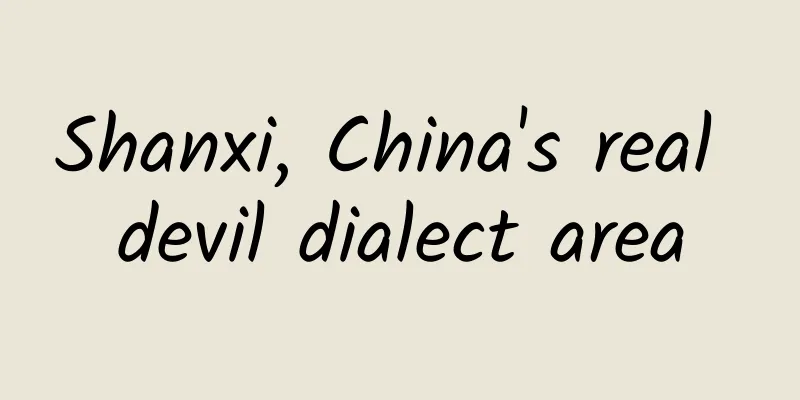Shanxi, China's real devil dialect area

|
Shanxi, as a provincial administrative unit, is always unknown on the Internet. Mention Shanxi, and most people's first reaction is: coal boss! The second reaction is: old vinegar. It seems that Shanxi people are the second generation of coal miners who grew up drinking old vinegar. In fact, there are many more interesting things about Shanxi, such as their dialect. If you have a Shanxi roommate in your dormitory, you will be shocked to hear him calling home. Why? Because I don’t understand. If we were to choose the most difficult dialect to understand in China, Shanxi dialect would definitely be on the list. Students from Hebei, Shandong and Northeast China can chat and laugh happily in their native dialects. But now, listening to Shanxi people, who are also from the north, is like listening to a coded telegram. Even Shanxi people themselves cannot understand other Shanxi people. I can't understand anything except a few interjections. What's going on? Shanxi dialect makes the whole North cry There are actually very few northern dialects that can stump northerners, because the northern dialect area is very consistent. Even though there is a distance of more than 3,000 kilometers between Harbin in the north and Kunming in the south, people in Harbin and Kunming still have no problem greeting each other with “ni zou sha” and “ni gui mei ri yan de”[1]. According to an experiment, Beijingers who had never heard Jinan dialect gave an average intelligibility score of 6.33 (out of 10) for Jinan dialect. Even in Shaanxi, where people from other places can still give Xi'an dialect a score of 6. Even in Sichuan, in the southwest, Beijingers gave Chengdu dialect a score of 6.71[2]. However, things are different in Shanxi. Beijing residents give their understanding of Taiyuan dialect an average score of only 2.67[2]. This is surprising considering that Taiyuan is not far from Beijing. Moreover, Taiyuan dialect is a variant of Shanxi dialect and is the most Beijing-like Shanxi dialect. If it's the "orthodox" Shanxi dialect, you may not understand a word. We are not the only ones who find it difficult. More than 100 years ago, people in the Qing Dynasty experienced how frustrating it was to understand Shanxi dialect. This point was also mentioned in a post promoting Mandarin at the time, "Petition to the Council of State for the Promulgation of Simplified Mandarin Characters". The reason why people from Shanxi and Hebei were hostile to each other and regarded each other as different... was entirely because their dialects were so different. Shanxi dialect is confusing just by listening, because its phonetic system is very different from that of northern dialects. If Zhejiang dialect is still like Japanese, then Shanxi dialect can only be like the Klingon language of the aliens in "Star Trek". △ In the American TV series "The Big Bang Theory", Sheldon often speaks Klingon / Bilibili In addition to having eight more initials than Beijing dialect, Shanxi dialect also has different finals. Many Shanxi dialects pronounce Mandarin complex finals as single vowels. For example, the Mandarin word ao may be pronounced as o by Shanxi dialect[4]. Some Shanxi dialects do not distinguish between yinping and yangping tones[4]. To them, there is no difference between the first and second tones in Mandarin. So when you hear Shanxi people say "The air in the fields is pretty good today", don't laugh at their accents, because in their ears, the first and second tones are the same. In addition to sounding so different from northern dialects, many of the word-building habits of Shanxi dialect also shocked our northern compatriots, such as the common use of diacritical marks and reversed words in Shanxi dialect[4]. A phonetic word is one that divides a character into two sounds and reads them as one word. It is said that this may be a legacy of ancient Chinese. It may sound strange at first, but this phenomenon also exists in Mandarin, such as the phonetic division of "孔" (kong), which is "孔咙", and the phonetic division of "扒" (ba), which is "扒拉", etc. But this phenomenon is very common in Shanxi dialect, for example, "ban" is pronounced as "bo lan", "gan" is pronounced as "ga lan", etc. Just imagine, listening to Shanxi people speak, you have to piece together their meaning like a jigsaw puzzle. I'm afraid you will be scared away as soon as the other person opens his mouth. Another anti-human existence is "reverse order words", that is, the order of many words is opposite to that of Mandarin. For example, the words “struggle”, “interrogation” and “tidy” in Mandarin are translated as “zhazheng”, “wenxun” and “neat” in Taiyuan dialect[4]. However, the biggest difficulty is the reduplication of words. There are not many reduplication of words in Mandarin, only kinship terms such as "爸爸妈妈" and animal terms such as "蝈蝈"[5]. However, Shanxi dialect has a rich variety of reduplication words, which can be divided into AA, ABB, AAB, AXBB and ABCC. From the daily words "Shui Shui" and "Fan Fan" to "Chong Chong Niu Niu" and "Shang'e Liang Liang", most Shanxi people are familiar with them.[5] △Shanxi, Taihang Mountain Range, in Shanxi dialect this is called "Shan Geliangliang" / "Aerial Photography of China·Shanxi" So, if you see a big man from Shanxi who opens his mouth and says "drink water", "stones", "egg yolk" or something like that, don't think he is being cute with you. Shanxi dialect, a language that even Shanxi people cannot understand The difficulty of Shanxi dialect is not limited to this. Sometimes when people from Taiyuan and Fenyang meet, they don't speak their local dialect but Mandarin. Why is that? Because the Shanxi dialect is not only difficult for outsiders, but also has many differences among locals. Even if a native of Shanxi is asked to listen to the Jincheng dialect, people from Changzhi may not understand much. The Jin dialect in Shanxi is divided into five areas: Bingzhou, Shangdang, Luliang, Dabao and Wutai. Each area has many different counties under its jurisdiction[6]. Therefore, people in the same area may not necessarily communicate smoothly. According to records from the 1980s, the county party secretary who was transferred from Hongdong County to Fenxi County could hardly understand what the local cadres were saying when they reported on their work. Fenxi is less than 100 miles away from Hongdong County, so you can imagine how great the differences in Shanxi dialect are.[3] △ Distribution map of Shanxi dialects / Hou Jingyi, Wen Duanzheng, & Tian Xicheng. (1986). Division of Shanxi dialects (draft). Dialects (2), 81-92. A scholar investigated the pronunciation of 116 commonly used words in 42 dialects in Shanxi Province and found that even for basic words, different dialects have different names for them [4]. Take the simplest “tomorrow” for example. Datong says “tomorrow”, Taiyuan says “minger” or “early rise”, Fenyang and Wenshui say “di ming”, and Changzhi says “mingri ge”. The most amazing one is Lingchuan dialect, which directly says “Qing Dynasty” which is quite impressive[4]. In Shanxi dialect, “yesterday” can also be called “yetian”, “yeli”, “yelai”, “yeri”, “yeerge”, etc.[4] Therefore, there are five or six ways to translate “Yesterday, Today and Tomorrow” in Shanxi dialect. △ The skit "Yesterday, Today, Tomorrow", if translated into Shanxi dialect, the name of the skit has 5 or 6 translations / Bilibili This is nothing. There are also significant differences in the way relatives are addressed within the province. For example, the maternal grandmother is called “grandmother” in the Central District, “grandmother” in the Wutai District, “grandmother” in the Yunzhong District, and “grandmother Jian” in the Western District. In many places in the Southern District, she is also called “uncle mother”[4]. So if your boyfriend is from Shanxi, don’t call his mother “po-in-law” as soon as you see her. Remember to ask first before calling her that. Seeing this, I guess many people are already feeling stressed. However, Shanxi dialect not only has big differences in vocabulary, but also in pronunciation. Although we often complain that people in the south cannot distinguish between flat and retroflex tongue sounds (zi zi si = weaving and eating poetry), our fellow Shanxi people in the north cannot fully distinguish between them either. Like Beijing dialect, Shanxi can distinguish between “增” pronounced as zeng and “争” and “蒸” pronounced as zheng only in the southern and southeastern regions such as Yangcheng, Linfen, and Yongji.[4] Most Shanxi people do not distinguish between Zeng and Zheng, the difference is just to varying degrees. For example, in Jincheng, Lingchuan and other places, people pronounce both "增" and "争" with a retroflex sound[4]. So in these places, no one would laugh at you if you pronounce "增值税" as "蒸值税". In most places, such as Taiyuan, Liulin and Changzhi, the mainstream pronunciation is zeng regardless of whether it is flat or retroflex.[4] So guess which famous book "Zan Zeng and Peace" is? Although not distinguishing between f- and h- is generally considered a tradition in the Hujian area, some Shanxi people also lag behind the northern people in this matter. For example, the Pingyao, Jiexiu, and Qixian dialects do not have the initial consonant f. Therefore, whenever the initial consonant f- is combined with u, it is always pronounced as “hu” [4]. Therefore, Feng Shaofeng would be pronounced as "Hong Shao Hong" here, and Faye Wong would become "Wang Hui". △ July 2, 2011, Changsha, Faye Wong's concert in Changsha. In Shanxi, "Wang Hui" is the correct pronunciation of her name / Bilibili As for the question of n and l, although most Shanxi people can distinguish them, some people still say “dad” for “head” and “fa lu” for “anger”. This phenomenon is mainly concentrated in southern Shanxi, namely Yuncheng, Pinglu, Houma and other places[4]. So if someone around you says that he has read "Anla Kalelila", don't rush to guess that he is from the south, maybe he is from Shanxi. When Shanxi people from all over the country gather together and speak their own dialects, the difference is just like when people from Sichuan, Hunan, Guangdong and Fujian speak together, it's impossible to understand them. Why is Shanxi dialect so special? The reason why Shanxi dialect is so different from northern dialects is that Shanxi dialect originally belongs to the Jin dialect area, not the northern dialect area. They are not born from the same mother, so it's normal that people from the north don't understand Shanxi dialect. As early as the Han Dynasty, the book “Dialects” mentioned “Qin and Jin languages”. It is said that when Duke Wen of Jin, Chong’er, traveled to Wei, Lu, Qi and other countries, he always used Qin and Jin languages to communicate, which shows the importance of Qin and Jin languages at that time [3]. However, this did not last long. Around the Song Dynasty, Jin dialect and Northern dialect separated and became increasingly distant. According to the Zhongyuan Yinyun in 1324, the Beijing dialect had already completed the process of dividing the level tone into two tones (yin and yang) (the emergence of the first and second tones) [3]. △ A photocopy of "Zhongyuan Yinyun". At that time, Beijing dialect already had yinping and yangping tones/Wikipedia However, some Shanxi dialects still do not have a clear distinction between masculine and feminine. To them, "Ma" and "Ma" sound the same. This suggests that Shanxi dialect had been developing separately from northern dialects since at least 1324.[7] Since the Northern Song Dynasty, the entering tone of Beijing dialect began to disappear, and by the Yuan Dynasty, it was completely replaced by the third tone. However, Jin dialect still retains the entering tone. From this perspective, Jin dialect has a history of 700-1000 years of independence from northern dialects [7]. The independence of Jin language is due to the geographical environment of Shanxi. Since ancient times, Shanxi has been quite isolated, with Taihang Mountain to the east, the Yellow River to the west and south, and Yinshan Mountain Range to the north. Most of Shanxi is located on a plateau with an altitude of more than 500 meters, and the living environment is harsh. Shanxi Province is also blocked by the Taiyue Mountains, the Luliang Mountains, and the Zhongtiao Mountains. These mountains, one after another, have prevented wars and foreign immigrants, thus protecting the local dialect.[3] For example, "Journey to the West" records that during the Central Plains War, there was chaos and war outside Niangzi Pass, but once inside Niangzi Pass, there was peace and prosperity. In contrast, due to the presence of the Fen River and the Yellow River, southern Shanxi is more convenient for traveling to the Guanzhong region of Shaanxi than to Taiyuan[3]. As a result, the region was “eroded” by Shaanxi’s Central Plains Mandarin, abandoned the Jin dialect, and instead became a Central Plains Mandarin area.[8] In addition, Shanxi has been a populous province since ancient times, with a large population and little land. According to statistics, in 1381, Henan had a population of 1.891 million, Hebei had a population of 1.893 million, and Shanxi alone had a population of 4.03 million, more than the population of the two provinces combined. With so many locals, it is natural that the country is not very attractive to immigrants.[9] The huge population has led to several waves of immigration in Shanxi’s history, such as the famous “Going West” and “Going to Yunzhong”[9]. Few people moved into Shanxi, but many left. As a result, Jin language not only avoided external impact, but also expanded its second battlefield outside the province. Today, western Inner Mongolia, Shaanxi, Zhangjiakou, Hebei and other places are also Jin language areas, which are unexpected gains from the immigration wave at that time [3]. According to legend, Wenzhou dialect was used as an intelligence code to keep intelligence secret during the Anti-Japanese War. However, many Wenzhou people have been wandering overseas for a long time, and their presence can even be seen all over the world, so it is inevitable that the code will be deciphered. Therefore, if you want to consider a safer and more reliable language, you can choose the various Shanxi dialects that have been isolated from the world for a long time. [1] Yuan Jiahua (1983). An Outline of Chinese Dialects, Chinese Character Reform Press [2]Tang, C., & van Heuven, VJ (2007). Mutual intelligibility and similarity of Chinese dialects: Predicting judgments from objective measures. Linguistics in the Netherlands, 24(1), 223-234. [3]Qiao Quansheng. (2004). On the formation of the Shanxi dialect area. Journal of Shanxi University: Philosophy and Social Sciences Edition (4), 17-21. [4] Hou Jingyi, & Wen Duanzheng (eds.). (1993). Shanxi dialect survey and research report. Shanxi University Joint Publishing House. [5] Ren Yijiao. (2017). Reduplication of nouns in Shanxi Jin dialect. (Doctoral dissertation). [6] Hou Jingyi, Wen Duanzheng, & Tian Xicheng. (1986). Division of Shanxi dialects (draft). Dialects (2), 81-92. [7]Qiao Quansheng. (2003). The asynchronous development of Jin dialect and Mandarin (I). Dialects (2), 147-160. [8] Wang Linhui. (2001). The phonetic characteristics and evolution of the Fenhe River Basin dialect. (Doctoral dissertation, China Social Sciences Press). [9] Liang Sibao, & Wu Fangmei. (2001). Population migration in Shanxi and the rise of southern Shanxi during the Ming and Qing dynasties. Studies in Chinese Social and Economic History (2), 54-60. Photo Editor | Liu Xiaopai WeChat Editor | Bobo Chicken Source | NetEase Inspur Studio |
>>: Are Hungarians descendants of the Huns?
Recommend
New Oriental: Tian Jing's core grammar and long and difficult sentences English 1 and English 2 courses
New Oriental: Tian Jing's Core Grammar and Lo...
Preliminary preparation for developing e-commerce WeChat applet
With the development of intelligence, mobile e-co...
Analysis of the Unicorn NetEase Cloud Music’s Competitive Products with Over 300 Million Users!
Before NetEase Cloud Music launched its first ver...
How does noise, the "big devil" of sound, break people's defenses?
Have you ever been disturbed by noise? For exampl...
The first killer app for Apple Watch is born
1Password is a very useful password manager for c...
Plastic pollutes the environment, how about using glass instead?
Plastic pollutes the environment, but we have to ...
Integrating social interaction + competitive sports intelligence interaction will usher in a new era of somatosensory games
Last week, the 2015 China Online Audiovisual Conf...
Top search! Mexico exhibits "alien remains", becoming the "first country to admit the existence of aliens"?
In the past two days, a hot search about aliens h...
The latest practical skills to make money through Tik Tok live streaming!
In fact, it is very simple to judge whether a per...
He was forced by a fly to do such a thing? It stumped millions of junior high school students!
“Fantasy is the wings of poets, and hypothesis is...
AnySDK beauty programmer Huang Yanli: Women's life and men's work
At the end of November 2014, on an ordinary after...
Angel or devil? Don’t be fooled by its cute appearance, it is actually very ferocious!
In the cold and dark deep sea, a cute little crea...
Google removes open source apps from Play Store for including website links
[[417771]] Language Transfer is an open source la...
A glimpse into the current status of VR game development at home and abroad: Are we falling behind this time?
Last Friday, a developer forum themed on VR games...
With wolves in front and tigers behind, is there still hope for Sony mobile phones?
The current smartphone market structure is basica...









